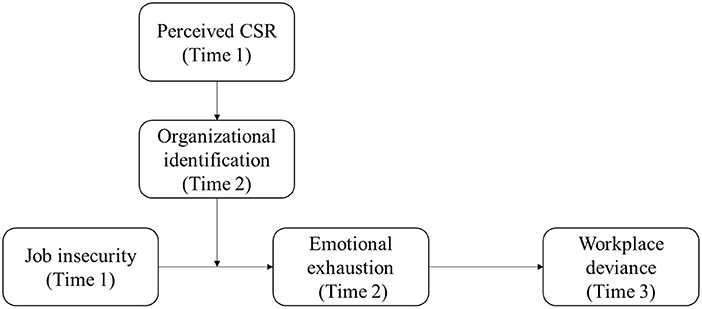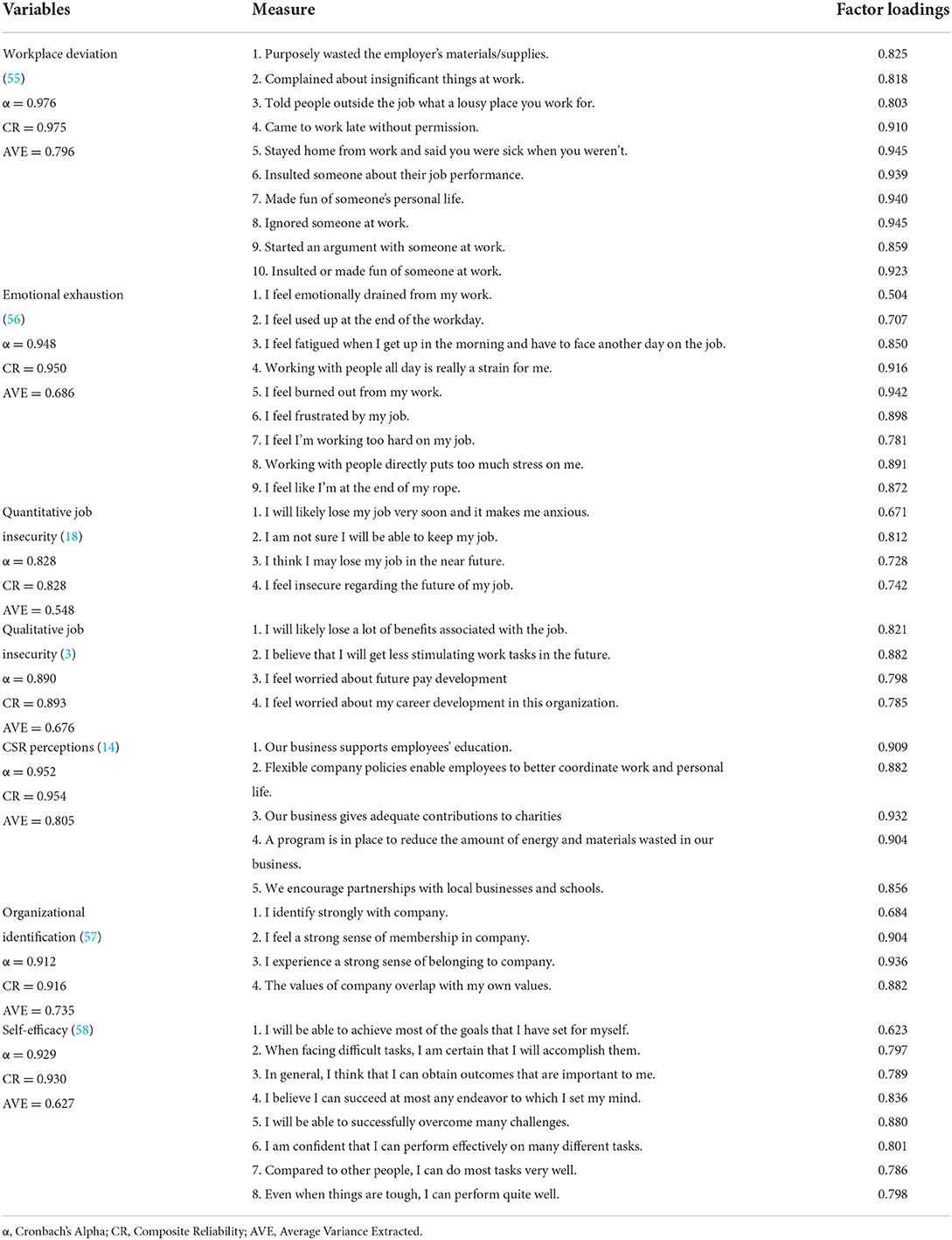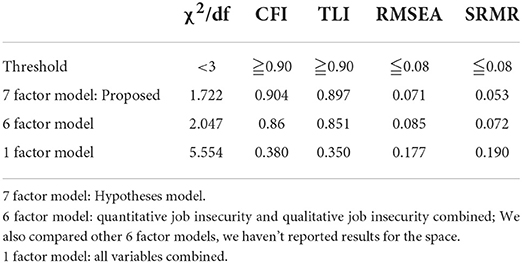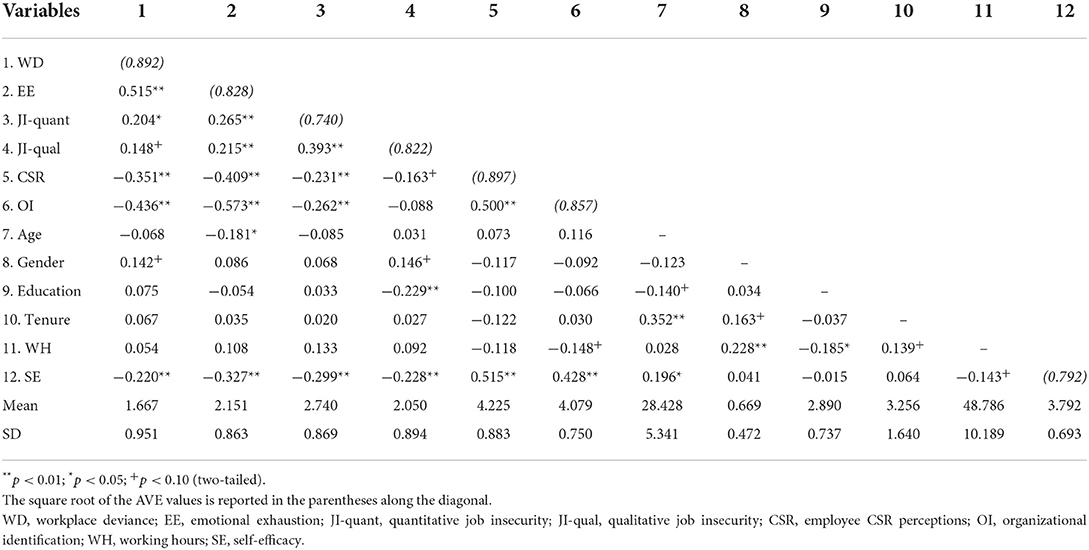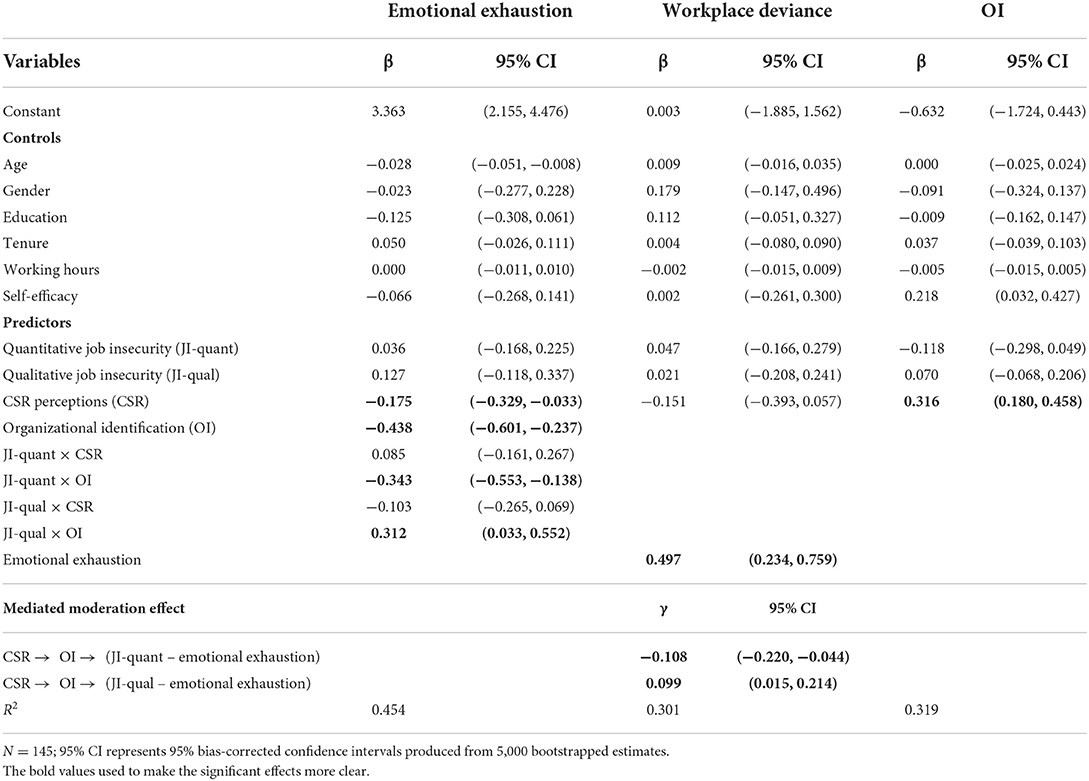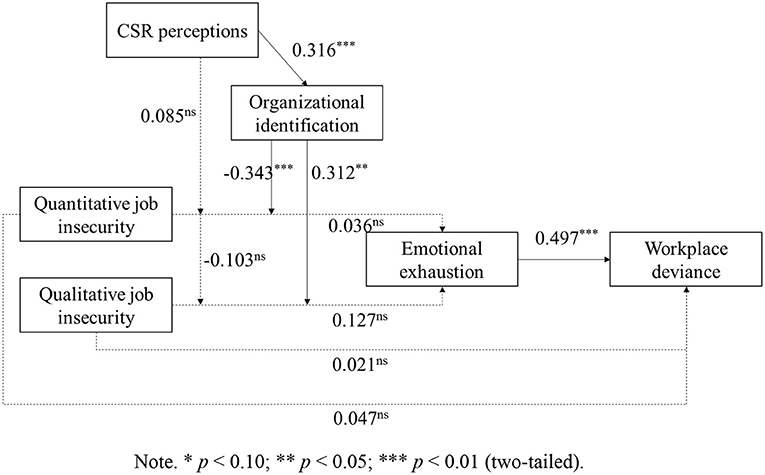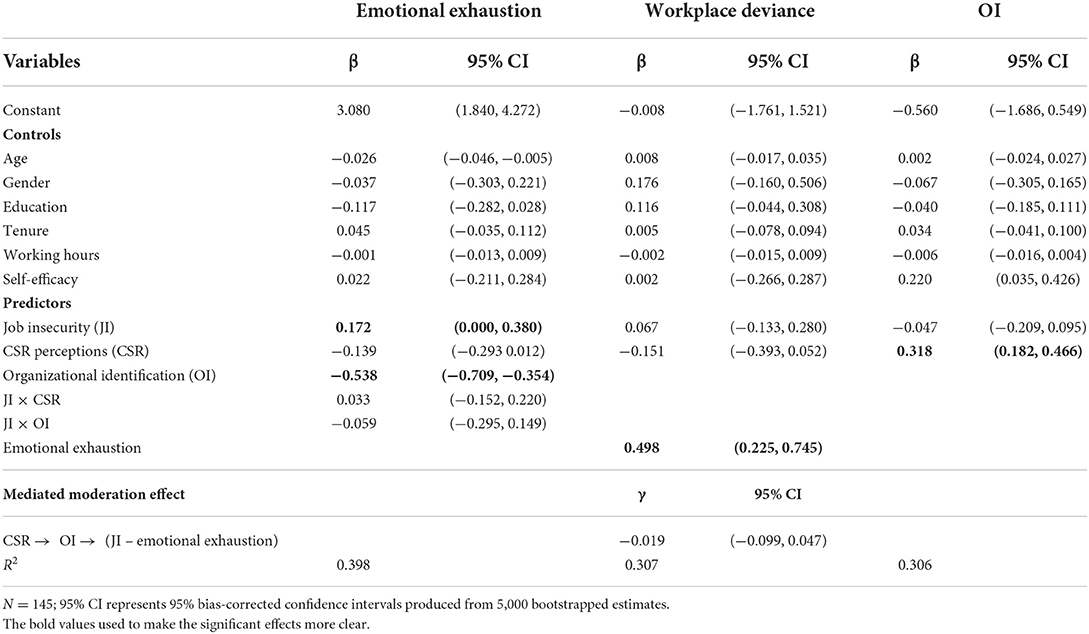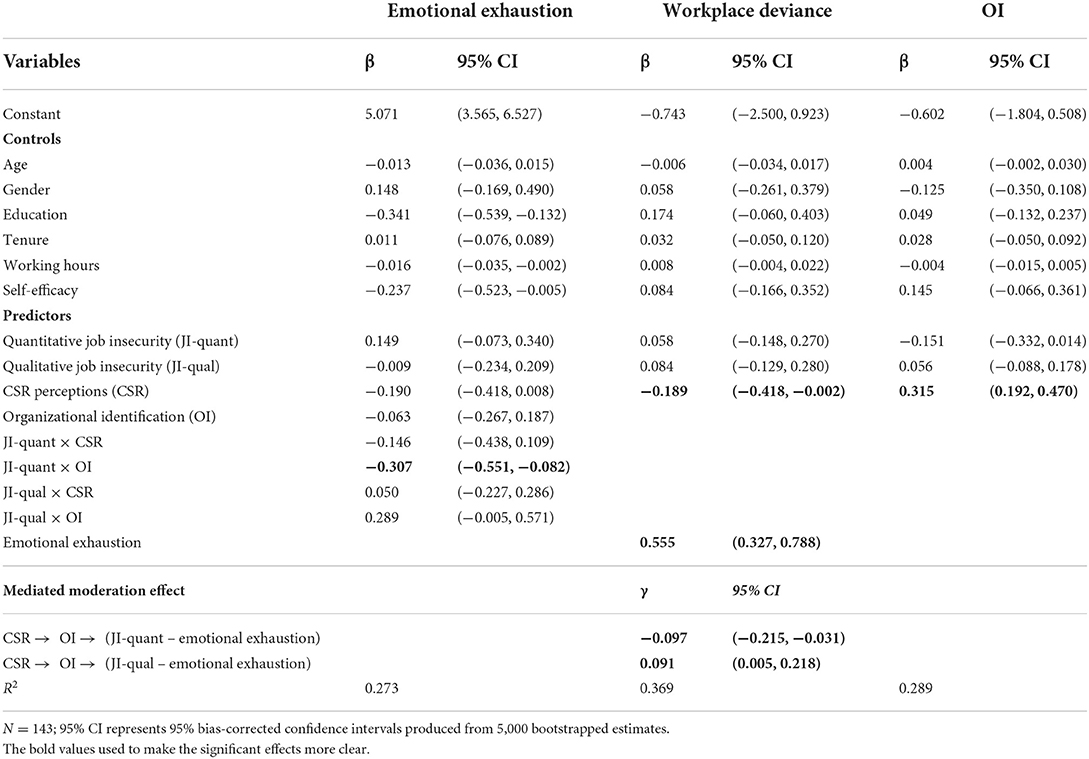- 1Hubei University, Wuhan, China
- 2Hubei Center for Studies of Human Capital Development Strategy and Policy, Key Research Base of Humanities and Social Science of Hubei Province, Wuhan, China
- 3Hubei University of Science and Technology, Xianning, China
Job insecurity is one of top concerns in the contemporary workplace, which significantly affects emotional exhaustion and workplace deviance. Thus, this study seeks to explore the buffering role of employees' corporate social responsibility (CSR) perceptions to against the effect of job insecurity. Based on micro-CSR literature and social identity theory, this study tested the proposition that employees' CSR perceptions moderate the relationship between job insecurity and emotional exhaustion through organizational identification. Using three-wave data collected from 145 employees in one of China's biggest computer equipment providers, we found that employees' CSR perceptions alleviate (exacerbate) the negative relationship between quantitative (qualitative) job insecurity and emotional exhaustion via organization identification. Our findings provided new insights to scholars and managers in dealing with job insecurity.
Introduction
Faced with the economic crisis, shifting governmental policies, and the outbreak of the coronavirus (COVID-19), the whole globe has entered into the VUCA (volatility, uncertainty, complexity, and ambiguity) and TUNA (turbulent, uncertain, novel, and ambiguity) world (1). Not surprisingly, such VUCA and TUNA context bring extreme pressures to job environment, leading to employers downsizing and outsourcing labor. Job insecurity has become one of top concerns in contemporary working life (2–4).
Job insecurity reflects the degree to which employees perceive threat to the continuity and stability of employment (4). Job insecurity is a work-related stress which can bring poor mental, physical, and work-related wellbeing (e.g., anger, emotional exhaustion, disengagement, and counterproductive work behaviors), and further lead to negative work-related performance [(5); see also (6) for a review]. Accordingly, prior studies explored several ways to buffer against the adverse consequences of job insecurity such as improving leader-member exchange (LMX) (7, 8), fostering organizational justices (5) and psychological capital as well (9). While, much more attention has been paid to the direct effect of job insecurity than to buffers that against the negative effect of job insecurity (10).
In this study, we introduced corporate social responsibility (CSR) as an essential factor in minimizing the negative consequences of job insecurity. CSR refers to “the firm's considerations of, and response to, issues beyond the narrow economic, technical, and legal requirements of the firm to accomplish social (and environmental) benefits along with the traditional economic gains which the firm seeks” [(11), p. 312]. From the perspective of employees, CSR is a notable aspect of their more general justice perceptions (12), employees perceptions about a firm's CSR can overwhelming affect employees' attitudes and behaviors toward the firm (e.g., organizational identification, attachment, satisfaction, and engagement) (13–15). Further, a firm's CSR can drive certain employee attitudes and behaviors to mitigate work stress (16) and turnover intention (17). In line with these studies, therefore, we explored whether or not employees' CSR perceptions can play a buffering role in dealing with job insecurity.
Based on prior study in the job insecurity literature, we developed the baseline framework about the job insecurity—emotional exhaustion—workplace deviance link. Then drawing on the micro-CSR literature and social identity theory, we explored the mechanism through which employees' CSR perceptions moderate the job insecurity and emotional exhaustion linkage. Figure 1 depicts the theoretical model of this study. We tested our model by carrying out a three-wave data collection approach.
This study makes two contributes to research and practice. First, we contributed to the micro-CSR literature by considering the role of employees' CSR perceptions in dealing with job insecurity. We explored how CSR perceptions moderate the relationship between job insecurity and emotional exhaustion through organizational identification. In this way, we found that CSR has both bright-side and dark-side effects on the negative influences of job insecurity. Second, we disclosed distinctive effects of quantitative and qualitative job insecurity on emotional exhaustion with regard to employees' CSR perception and organizational identification. Our study advances current understanding about the effect of job insecurity and how organizations shape such effects that we identified.
Literature review and hypotheses
Relationship among job insecurity, emotional exhaustion, and workplace deviance
Job insecurity is one type of work-related stress, a subjective experience that denotes perceived threats to the job as a whole and its continued existence in the future (4, 18). The individual feels insecure in a job can range from losing one's job ultimately to losing some important features of the job (e.g., wage, promotion opportunities, and work conditions) (19). Accordingly, Hellgren et al. (20) introduced quantitative and qualitative aspects of job insecurity. Quantitative job insecurity is described as concerns about loss of the job itself, whereas qualitative job insecurity is related to perceived threats of losing valuable job features (3, 20). Job insecurity also can be distinguished by cognitive and affective job insecurity. Affective insecurity is associated with emotional state (e.g., concern, worry, and fear) (21), while cognitive insecurity is more likely to relate to job attitudes (e.g., engagement and commitment) (6).
Emotional exhaustion can be defined as “feelings of being emotionally overextended and depleted of one's emotional resources” [(22), p. 399]. From the conservation of resource theory (COR) perspective, it suggested that job insecurity threats an employee's resources and therefore triggers strain in the physical and mental exhaustion (6, 23). Thus, job insecurity is positively related to emotional exhaustion (2, 6, 23).
Workplace deviance refers to purposeful behavior that violates organizational norms and is intended to threaten the wellbeing of an organization, its employees, or both (24). Deviance behaviors can lead directly toward individuals (i.e., interpersonal workplace deviance such as aggression, rudeness, and gossiping), and toward the organization (i.e., organizational workplace deviance such as shirking hours, stealing from a company, and leaving early or arriving late to work) (7, 25, 26). Studies suggested that workplace deviance may occur when employees experience high level of job insecurity (4, 7). For instance, Tian et al. (27) argued that job insecurity brings traumas and makes employees do counter-productive behavior (e.g., workplace deviance). Likewise, Huang et al. (7) suggested that job insecurity triggers moral disengagement, leading to interpersonal and organizational deviance. In addition, emotionally exhausted employees are lack of resources to meet job demands and protect their remaining resources, they will become dissatisfied with their current job and then react by deviant behaviors [e.g., (28–30)].
Based on prior literature about the relationship among job insecurity, emotional exhaustion and workplace deviance, we built on the baseline framework about how job insecurity positively relates to emotional exhaustion, which in turn leads to increased workplace deviance.
The role of employee CSR perceptions
Employee CSR perceptions refer to the overall perception about which employees view their firms' various CSR activities (14, 17). It captures how employees perceive their firms' CSR efforts, a subjective reaction about firms' objective CSR actions (17, 31). Employee's CSR perceptions can impact employees' emotions, attitudes, and behaviors toward their organizations (14, 17), because CSR caters to employees' deontic needs, i.e., employees not only react to the treatment they themselves received but also to the treatment of others (31). El Akremi et al. (32) further argued “employees as members of a corporation, are concerned about, contribute to, perceive, evaluate, and react to their firm's CSR activities” (p. 621). Thus, higher level of CSR perceptions can improve employees' organizational trust, pride, organizational identification [for a meta-analysis see (33)].
In addition, CSR can be used in an instrumental way to prevent certain employee attitudes and behaviors that harm a firm's performance (e.g., turnover intention, employee cynicism, and workplace gossip) (34, 35). For example, Flammer and Luo (36) revealed that CSR can be used as an employee governance tool to increase employee engagement and counter the possibility of adverse behavior. Schwepker et al. (16) found that organizational ethics (i.e., ethical leadership, ethical climate, and CSR) mitigate work-related stress and promote employee wellbeing.
In this study, we expected that employee CSR perceptions mitigate the effect of job insecurity on emotional exhaustion. Job insecure employees face high level of strain and uncertainty about their job, which can deplete the physical, psychological, and mental energy of employees (37). Their energy and mental resources have been entirely consumed by work (23). At that time, perceived CSR may play a buffering role in decreasing the negative effect of job insecurity on emotional exhaustion. First, CSR activities can improve employees' psychological and physiological wellbeing (16). More responsible firms will cultivate a safer and protective context, provide employees safe working environment, daycare programs, training, and other resources related the job, all can help employees to better adjust their long-term career planning, deal with career shock, and reduce the potential threats to job continuity and stability (2, 38). For one extreme example, when COVID-19 pandemic brings death anxiety to employees, employees perceived internal CSR leaves employees feeling less threatened by the pandemic (39).
Second, employee CSR perceptions reflect firm's objective CSR actions toward inside and outside of organizations, including internal CSR (practices aimed at improving employees' wellbeing, such as employee training, safe working conditions, and daycare programs) and external CSR (practices directed to outside-stakeholders' wellbeing, such as pollution prevention and philanthropy), all can contribute to employees' experienced meaningfulness of work (40, 41) and psychological safety (organizational support) (42, 43). A high level of meaningfulness of work leads employees to define stressors as welcomed challenges that are worthwhile to invest energy to deal with (44), and a high level of psychological safety provides relieved, secure, and calm environment to employees, all of which can reduce the challenges of job insecurity on emotional exhaustion. Taken together, we hypothesized the following:
Hypothesis 1: Employee CSR perceptions attenuate the relationship between job insecurity and emotional exhaustion.
Social identity theory suggested that “people tend to categorize themselves and others into social groups to develop a positive self-concept by identifying with groups that enhance their self-esteem” [(45), p. 1725, (46)]. When employees define themselves in terms of the organization, and a feeling of belonging to the group, employees have high level of organizational identification (47). Organizational identification increases employees' work behaviors (e.g., commitment, work engagement and job performance) (45, 48).
We proposed that organizational identification mediates the moderating effect of employees' CSR perceptions on the association between job insecurity and emotional exhaustion. First, scholars found that employees view socially responsible firms as respected and attractive organizations, they have greater organizational pride and commitment to such organizations, which in turn increase organizational identification (13, 33, 49). Second, when employees develop high levels of organizational identification, as members of their organization may tolerate workplace stressors (50, 51). In a similar vein, employees who identify strongly with their organization perceive a high sense of organizational support (52) and organizational trust (13), which can offset the negative consequence of job insecurity [e.g., (3, 10, 53)]. Combined with Hypothesis 1, we inferred that CSR perceptions may increase organizational identification at first, then organizational identification moderates the relationship between job insecurity and emotional exhaustion. Formally, we hypothesized the following:
Hypothesis 2: The moderating effect of Employee CSR perceptions on the relationship between job insecurity and emotional exhaustion is explained through organizational identification.
Methods
Data and sample
We collected data from one of the biggest computer equipment providers in the middle of China during October 10 in 2020 and May 23 in 2021. This company conducted direct online sales and provided customized computer equipment to individual customers. Firms in the computer industry are experiencing fierce market competition and great pressure to innovate (54), employees in such an industry are valued by key performance indicators (or KPI) and face high level of emotional exhaustion. With the support of the chief executive officer, we obtained all employees' name and job number. We coded each questionnaire with a unique number and contacted corresponding employees to answer the questionnaire. The code is difficult to recognize, which can reduce responders' concern of social desirability bias. We collected data in three-waves. At Time 1, we collected job insecurity, perceived CSR, self-efficacy, and demographic variables. At Time 2, we collected emotional exhaustion and organizational identification. Then, at Time 3, we repeated the same process to collect emotional exhaustion and organizational identification, we further collected workplace deviation. The average gap between the time points was 60 days.
Two hundred fifty-four employees participated in Time 1, which dropped to 211 at Time 2, and 149 at Time 3. Four participants were dropped for the missing values in their demographic information. Thus, our final samples include 145 respondents. 66.90% were males and 33.10% were female. The average age was 28.43 (SD = 5.34), the average tenure was 3.26 years (SD = 1.64), the average working hours in 1 week was 48.79 (SD = 10.19). Regarding education, 3.45% of respondents had a middle school education, 22.76% had a high school or vocational school education, 55.17% had a junior college education, and 18.62% were bachelor's degree holders.
Measures
All measurement scales were adapted from the existing literature. Using back-translation approach, we translated the English scales to Chinese at first, then translated back into English to ensure equivalence of meanings. All measures were rated on a 5-point Likert scale (1 = strongly disagree to 5 = strongly agree) (see Table 1).
Workplace deviation
Following prior studies [e.g., (59–61)], we measured workplace deviation using a 10-item scale developed by Spector et al. (55). Qin et al. (60) argued that many deviant behaviors are done privately without others' knowledge, a self-reported measure of workplace deviation can disclose such workplace deviation [e.g., (62, 63)]. A sample item is: “purposely wasted the employer's materials/supplies.” The Cronbach's alpha for this variable was 0.976.
Emotional exhaustion
Following prior studies [e.g., (28, 64, 65)], we measured emotional exhaustion using a 9-item scale developed by Maslach and Jackson (56). A sample item is: “I feel emotionally drained from my work.” The Cronbach's alpha for this variable was 0.948.
Job insecurity
Hellgren et al. (20) argued that job insecurity could be classified by qualitative job insecurity (i.e., treats of losing valued job features) and quantitative job insecurity (i.e., subjective assessments regarding the potential loss of the job itself). While most prior empirical studies focused on quantitative job insecurity, in this study we measured both qualitative and quantitative job insecurity separately. Quantitative job insecurity was measured by a 4-item scale developed by De Witte (18). A sample item is: “I will likely lose my job very soon and it make me anxious.” The Cronbach's alpha for this variable was 0.828. Qualitative job insecurity was measured by a 4-item scale adopted from Probst et al. (3). A sample item is: “I feel worried about my career development in this organization.” Cronbach's alpha for this variable was 0.890.
Employee CSR perceptions
We measured employee perceived CSR using a 5-item scale developed by Rupp et al. (14). It contains five issues including educational programs for employees, corporate philanthropy, green initiatives, community partnerships, and staff work-life balance programs. A sample item is: “our business supports employees' education.” The Cronbach's alpha for this variable was 0.891.
Organizational identification
We measured organizational identification using a 4-item scale developed by Smidts et al. (57). A sample item is: “I identify strongly with the company.” The Cronbach's alpha for this variable was 0.912.
Control variables
We controlled for several variables that may impact on firm's emotional exhaustion and workplace deviation (60), including age, gender, education level, tenure, working hours, and self-efficacy. Age was in years; gender was coded as 1 for male and 0 for female; educational level was coded as 1 for middle school, 2 for high school or vocational school, 3 for junior college, and 4 for bachelor's; tenure was in years, working hours in 1 week was in hours. Self-efficacy was measured by 8-items developed by Chen et al. (58). A sample item is: “I will be able to achieve most of the goals that I have set for myself.” The Cronbach's alpha for this variable was 0.929.
Common method variance
Using self-reported measurement can result in common method variance (CMV) (66), we conducted two ways to ensure CMV was not a problem within our data. First, Harman's (67) one-factor test shows a factor that accounts for 35.93% of the variance. A principle component analysis on all items yielded seven factors that together account for 76.49%. Second, following Podsakoff et al. (66), A single-factor confirmatory factor analysis (CFA) in Mplus 7.0 software shows the model fit deteriorates ( = 5,009.797, p < 0.001, CFI = 0.380, TLI = 0.350, RMSEA = 0.177, SRMR = 0.190). Thus, CMV was less of a concern in this study.
Results
We first conducted analyses to ensure the reliability and validity of the measures. We conducted CFA in Mplus 7.0 software to evaluate model fit of hypotheses model (see the results from Table 2). It reveals that the 7-factor model provides a good fit ( = 1,513.644, p < 0.001, CFI = 0.904, TLI = 0.897, RMSEA = 0.071, SRMR = 0.053). All scale items loaded on their intended factors significantly. As shown in Table 1, we checked the reliability by using Cronbach's α and the composite reliabilities (CR), all above commonly accepted thresholds. We also examined the convergent validity (average variance extracted, AVE) and discriminant validity. AVE for all variables exceeded the 0.50 benchmark. The discriminant validity shows that the 7-factor model is better than any 6-factor models. We further found that the values of the square root of AVE are higher than the correlations between variables, it reveals that the discriminant validity is appropriate. Overall, these results satisfied the validity and validity.
Table 3 presents the means, standard deviations, and correlations among variables. Consistent with prior studies, quantitative and qualitative job insecurity were positively correlated with emotional exhaustion (r = 0.265 and 0.215, p < 0.01, respectively), emotional exhaustion was positively associated with workplace deviance (r = 0.515, p < 0.01). Further, quantitative job insecurity was positively related to qualitative job insecurity (r = 0.393, p < 0.01).
We tested our hypotheses with hierarchical moderated regression in Mplus 7.0. Following Cohen et al. (68), we mean-centered variables to calculate the interactions of job insecurity with CSR perceptions and job insecurity with organizational identification. Hypothesis 1 predicted that CSR perceptions would moderate the association between job insecurity and emotional exhaustion. As Table 4 and Figure 2 shows, we found non-significant interaction effects between quantitative job insecurity and CSR perceptions [β = 0.085, 95% CI (−0.161, 0.267)], and between qualitative job insecurity and CSR perceptions [β = −0.103, 95% CI (−0.265, 0.069)], on emotional exhaustion. Thus, Hypothesis 1 was not supported. It suggests that employee CSR perceptions can't moderate the effect of job insecurity on emotional exhaustion directly.
Hypothesis 2 stated that organization identification mediates the moderation effect of CSR perceptions on the relationship between job insecurity and emotional exhaustion. We completed the test by the suggestion from Edwards and Lambert (69) and other studies [e.g., (70, 71)]. In Table 4, CSR perceptions was significantly related to organizational identification [β = 0.316, 95% CI (0.180, 0.458)], the interaction effect between organizational identification and job insecurity on emotional exhaustion is significant [β = −0.343, 95% CI (−0.553, −0.138); β = 0.312, 95% CI (0.033, 0.552), respectively]. We constructed bias-corrected confidence intervals by drawing 5,000 random samples with replacement from the full sample. The indirect effect results reveal that organizational identification mediated the moderation effect of CSR perception on the relationship between quantitative job insecurity and emotional exhaustion [γ = −0.108, 95% CI (−0.220, −0.044)], and the relationship between qualitative job insecurity and emotional exhaustion [γ = 0.099, 95% CI (0.015, 0.214)], thus supporting for Hypothesis 2.
Supplement analyses
(1) We combined quantitative and qualitative job insecurity into a unidimensional construct as previous studies have been conducted (2, 7). We repeated our analyses and the results can be seen in Table 5. Consistent with previous study, we found job insecurity positively relates to emotional exhaustion [β = 0.172, 95% CI (0.000, 0.380)], emotional exhaustion positively associates with workplace deviance [β = 0.498, 95% CI (0.225, 0.745)], and emotional exhaustion mediates job insecurity and workplace deviance [γ = 0.086, 95% CI (0.004, 0.258)]. Thus, our base-line model (JI → emotional exhaustion → workplace deviance) was supported. Yet, quite different from the main results in Table 4, we found a non-significant mediated moderation effect [γ = −0.019, 95% CI (−0.099, 0.047)], suggesting that effects differ according to quantitative vs. qualitative job insecurity.
(2) We also measured emotional exhaustion at Time 3, so we examined the lagged effect of moderating effect of employee CSR perceptions on the relationship between job insecurity and emotional exhaustion. The Cronbach's alpha for emotional exhaustion was 0.948. We repeated our analyses and found similar results (see detail from Table 6).
Discussion
Job insecurity is one of top concerns in the current workforce. Integrating micro-CSR literature and social identify theory, we hypothesized and tested whether employee perceived CSR plays a buffer role to the negative effect of job insecurity. We found that when job insecurity was considered as a unidimensional construct, the moderation role of employee CSR perceptions was not supported. In contrast, a nuance perspective shows that employee CSR perceptions moderate the link between quantitative and qualitative job insecurity and emotional exhaustion indirectly through organizational identification.
More interestingly, employee CSR perceptions alleviate (exacerbate) the negative relationship between quantitative (qualitative) job insecurity and emotional exhaustion via organization identification. Quantitative job insecurity implies a loss of job itself and qualitative job insecurity implies a loss of valued job features, thus the former concerns the frustration of a general need (security need) and the later concerns the frustration of a particular need (growth needs) (72, 73). Organizational identification generated by CSR will satisfy several individual needs including safety, affiliation, and uncertainty reduction (74, 75), which all relate to security need instead of growth need. Lawrence and Kacmar (76), further, argued that facing job insecurity the high level of attachment and embeddedness to organization will do harm to regulate employees' feelings and redirect their attention to new job opportunities. Therefore, CSR and organizational identification play different roles with respect to quantitative vs. qualitative job insecurity.
Theoretical implications
This study makes two contributions to the literature. First, to the micro-CSR literature, this study is one of the first studies that considered employee perceived CSR in dealing with the negative effect of job insecurity. CSR cannot be a panacea, it has both bright-side and dark-side effects (41, 77, 78). While, mostly prior studies considered only the desirable or the undesirable results of CSR separately [e.g., (79–81)], this study revealed both effects exist. Furthermore, we introduced organizational identification as a mechanism for explaining the moderating effects of CSR perceptions on the relationship between job insecurity and emotional exhaustion. Thus, this study provides a deeper understanding about how employees' CSR perceptions react to the insecure job environment.
Second, to the job insecurity research, we responded Shoss's (4) suggestion that “future work should examine whether effects differ according to quantitative vs. qualitative job insecurity” (p. 1934) [see also from Jiang and Lavaysse (6)]. A unidimensional construct of job insecurity leads to emotional exhaustion and further to workplace deviance, but such relationship become non-significant when we divided job insecurity into quantitative and qualitative job insecurity. Moreover, quantitative and qualitative job insecurity generate distinctive effects on emotional exhaustion when considering employees' CSR perceptions and organizational identification. Thus, our study advances the current understanding about the effect of job insecurity and how to shape such effects.
Managerial implications
Based on our empirical results, this study is also important for managers. Managers should pay attention to the risk of job insecurity to employees' emotional exhaustion and workplace deviance. When facing job insecure employees, managers should distinguish job insecurity from quantitative vs. qualitative job insecurity at first. If employees face quantitative job insecurity, managers can proactively engage in CSR and use communication efforts to enhance CSR awareness to employees. Our results suggest that CSR perceptions generate organizational identification, which can mitigate the negative effect of quantitative job insecurity. While, if employees face qualitative job insecurity, of course engaging in CSR activities is good, but communicating CSR to employees may produce counterproductive effects.
Limitations and future research directions
This study has several limitations that should be addressed in the future. First, we found one way through which employee CSR perceptions moderate the relationship between job insecurity and emotional exhaustion, prior micro-CSR studies considered multiple ways through which employees perceived CSR leads to organizational and individual outcomes, such as organizational trust, organizational pride, psychological safety, and meaningfulness of work [e.g., (17, 78, 82)]. Future studies can consider those mechanisms related to employee CSR perceptions and their effects to alleviate or exacerbate the negative impact of job insecurity.
Second, future studies might consider other outcomes that are derived from job insecurity. For example, job insecurity yields moral disengagement (3, 7), whether employee CSR perceptions play a role in the job insecurity-moral disengagement link.
Third, although this study used three-wave data collection to minimize CMV problems and disentangle the causal order of our variables, we recommended further research using experimental and field studies to obtain more substantial causal effects.
Data availability statement
The original contributions presented in the study are included in the article/supplementary material, further inquiries can be directed to the corresponding author.
Ethics statement
The studies involving human participants were reviewed and approved by Hubei University. The patients/participants provided their written informed consent to participate in this study.
Author contributions
XJ has developed the research model, analyzed the data, and co-drafted the manuscript. SL has helped to collect the data and co-drafted the manuscript. WY has edited the manuscript. All authors contributed to the article and approved the submitted version.
Funding
This work was funded by the Young Scientists Fund of the National Natural Science Foundation of China (Grant Nos. 71902056 and 71802073) and Young Scientists Foundation of Innovative Research Team in Hubei University (HBQN0103).
Conflict of interest
The authors declare that the research was conducted in the absence of any commercial or financial relationships that could be construed as a potential conflict of interest.
Publisher's note
All claims expressed in this article are solely those of the authors and do not necessarily represent those of their affiliated organizations, or those of the publisher, the editors and the reviewers. Any product that may be evaluated in this article, or claim that may be made by its manufacturer, is not guaranteed or endorsed by the publisher.
References
1. Scoblic JP. Learning from the future: how to make robust strategy in times of deep uncertainty. Harvard Bus Review. (2020). Available online at: https://www.ffcoi.org/wp-content/uploads/2020/07/Learning-from-the-Future-HBR-2020.pdf
2. Lin W, Shao Y, Li G, Guo Y, Zhan X. The psychological implications of COVID-19 on employee job insecurity and its consequences: the mitigating role of organization adaptive practices. J Appl Psychol. (2021) 106:317–29. doi: 10.1037/apl0000896
3. Probst TM, Petitta L, Barbaranelli C, Austin C. Safety-related moral disengagement in response to job insecurity: counterintuitive effects of perceived organizational and supervisor support. J Bus Ethics. (2020) 162:343–58. doi: 10.1007/s10551-018-4002-3
4. Shoss MK. Job insecurity: an integrative review and agenda for future research. J Manage. (2017) 43:1911–39. doi: 10.1177/0149206317691574
5. Wang HJ, Lu CQ, Siu OL. Job insecurity and job performance: the moderating role of organizational justice and the mediating role of work engagement. J Appl Psychol. (2015) 100:1249–58. doi: 10.1037/a0038330
6. Jiang L, Lavaysse LM. Cognitive and affective job insecurity: a meta-analysis and a primary study. J Manage. (2018) 44:2307–42. doi: 10.1177/0149206318773853
7. Huang GH, Wellman N, Ashford SJ, Lee C, Wang L. Deviance and exit: the organizational costs of job insecurity and moral disengagement. J Appl Psychol. (2017) 102:26. doi: 10.1037/apl0000158
8. Loi R, Ngo HY, Zhang L, Lau VP. The interaction between leader–member exchange and perceived job security in predicting employee altruism and work performance. J Occup Organ Psychol. (2011) 84:669–85. doi: 10.1348/096317910X510468
9. Darvishmotevali M, Ali F. Job insecurity, subjective well-being and job performance: the moderating role of psychological capital. Int J Hosp Manage. (2020) 87:102462. doi: 10.1016/j.ijhm.2020.102462
10. Lee C, Huang GH, Ashford SJ. Job insecurity and the changing workplace: recent developments and the future trends in job insecurity research. Annu Rev Organ Psychol Organ Behav. (2018) 5:335–59. doi: 10.1146/annurev-orgpsych-032117-104651
11. Davis K. The case for and against business assumptions of social responsibilities. Acad Manage J. (1973) 16:312–22. doi: 10.2307/255331
12. Aguilera RV, Rupp DE, Williams CA, Ganapathi J. Putting the S back in corporate social responsibility: a multilevel theory of social change in organizations. Acad Manage Rev. (2007) 32:836–63. doi: 10.5465/amr.2007.25275678
13. Farooq O, Rupp DE, Farooq M. The multiple pathways through which internal and external corporate social responsibility influence organizational identification and multifoci outcomes: the moderating role of cultural and social orientations. Acad Manage J. (2017) 60:954–85. doi: 10.5465/amj.2014.0849
14. Rupp DE, Shao R, Skarlicki DP, Paddock EL, Kim TY, Nadisic T. Corporate social responsibility and employee engagement: the moderating role of CSR-specific relative autonomy and individualism. J Organ Behav. (2018) 39:559–79. doi: 10.1002/job.2282
15. Tian Q, Robertson JL. How and when does perceived CSR affect employees' engagement in voluntary pro-environmental behavior? J Bus Ethics. (2019) 155:399–412. doi: 10.1007/s10551-017-3497-3
16. Schwepker CH Jr, Valentine SR, Giacalone RA, Promislo M. Good barrels yield healthy apples: organizational ethics as a mechanism for mitigating work-related stress and promoting employee well-being. J Bus Ethics. (2021) 174:143–59. doi: 10.1007/s10551-020-04562-w
17. Ng TW, Yam KC, Aguinis H. Employee perceptions of corporate social responsibility: effects on pride, embeddedness, and turnover. Pers Psychol. (2019) 72:107–37. doi: 10.1111/peps.12294
18. De Witte H. Arbeidsethos en jobonzekerheid: meting en gevolgen voor welzijn, tevredenheid en inzet op het werk. In:Bouwen R, De Witte K, De Witte H, Tailleu T, , editors. Van Groep Naar Gemeenschap Liber Amicorum Prof Dr Leo Lagrou Garant, Leuven, (2000). p. 325–50.
19. Greenhalgh L, Rosenblatt Z. Job insecurity: toward conceptual clarity. Acad Manage Rev. (1984) 9:438–48. doi: 10.5465/amr.1984.4279673
20. Hellgren J, Sverke M, Isaksson K. A two-dimensional approach to job insecurity: consequences for employee attitudes and well-being. Eur J Work Org Psychol. (1999) 8:179–95. doi: 10.1080/135943299398311
21. Huang GH, Lee C, Ashford S, Chen Z, Ren X. Affective job insecurity: a mediator of cognitive job insecurity and employee outcomes relationships. Int Stud Manage Org. (2010) 40:20–39. doi: 10.2753/IMO0020-8825400102
22. Maslach C, Schaufeli WB, Leiter MP. Job burnout. Annu Rev Psychol. (2001) 52:397–422. doi: 10.1146/annurev.psych.52.1.397
23. Schumacher D, Schreurs B, Van Emmerik H, De Witte H. Explaining the relation between job insecurity and employee outcomes during organizational change: a multiple group comparison. Hum Resour Manage. (2016) 55:809–27. doi: 10.1002/hrm.21687
24. Robinson SL, Bennett RJ. A typology of deviant workplace behaviors: a multidimensional scaling study. Acad Manage J. (1995) 38:555–72. doi: 10.5465/256693
25. Berry CM, Ones DS, Sackett PR. Interpersonal deviance, organizational deviance, and their common correlates: a review and meta-analysis. J Appl Psychol. (2007) 92:410–24. doi: 10.1037/0021-9010.92.2.410
26. Christian MS, Ellis AP. Examining the effects of sleep deprivation on workplace deviance: a self-regulatory perspective. Acad Manage J. (2011) 54:913–34. doi: 10.5465/amj.2010.0179
27. Tian Q, Zhang L, Zou W. Job insecurity and counterproductive behavior of casino dealers–the mediating role of affective commitment and moderating role of supervisor support. Int J Hosp Manage. (2014) 40:29–36. doi: 10.1016/j.ijhm.2014.03.005
28. Chen H, Richard OC, Boncoeur OD, Ford DL Jr. Work engagement, emotional exhaustion, and counterproductive work behavior. J Bus Res. (2020) 114:30–41. doi: 10.1016/j.jbusres.2020.03.025
29. Kong DT, Ho VT, Garg S. Employee and coworker idiosyncratic deals: implications for emotional exhaustion and deviant behaviors. J Bus Ethics. (2020) 164:593–609. doi: 10.1007/s10551-018-4033-9
30. Mulki JP, Jaramillo F, Locander WB. Emotional exhaustion and organizational deviance: can the right job and a leader's style make a difference? J Bus Res. (2006) 59:1222–30. doi: 10.1016/j.jbusres.2006.09.001
31. Rupp DE, Shao R, Thornton MA, Skarlicki DP. Applicants' and employees' reactions to corporate social responsibility: the moderating effects of first-party justice perceptions and moral identity. Pers Psychol. (2013) 66:895–933. doi: 10.1111/peps.12030
32. El Akremi A, Gond JP, Swaen V, De Roeck K, Igalens J. How do employees perceive corporate responsibility? Development and validation of a multidimensional corporate stakeholder responsibility scale. J Manage. (2018) 44:619–57. doi: 10.1177/0149206315569311
33. Zhao X, Wu C, Chen CC, Zhou Z. The influence of corporate social responsibility on incumbent employees: A meta-analytic investigation of the mediating and moderating mechanisms. J Manage. (2022) 48:114–46. doi: 10.1177/0149206320946108
34. Archimi CS, Reynaud E, Yasin HM, Bhatti ZA. How perceived corporate social responsibility affects employee cynicism: the mediating role of organizational trust. J Bus Ethics. (2018) 151:907–21. doi: 10.1007/s10551-018-3882-6
35. Mehmood K, Jabeen F, Iftikhar Y, Acevedo-Duque Á. How employees' perceptions of CSR attenuates workplace gossip: a mediated-moderation approach. In: Academy of Management Proceedings, Vol. 2021. Briarcliff Manor, NY: Academy of Management (2021). p. 13566.
36. Flammer C, Luo J. Corporate social responsibility as an employee governance tool: evidence from a quasi-experiment. Strategic ManageJ. (2017) 38:163–83. doi: 10.1002/smj.2492
37. Shin Y, Hur WM. Supervisor incivility and employee job performance: the mediating roles of job insecurity and amotivation. J Psychol. (2020) 154:38–59. doi: 10.1080/00223980.2019.1645634
38. Mirvis P. Employee engagement and CSR: transactional, relational, and developmental approaches. Calif Manage Rev. (2012) 54:93–117. doi: 10.1525/cmr.2012.54.4.93
39. Shao R, He L, Chang CH, Wang M, Baker N, Pan J, et al. Employees' reactions toward COVID-19 information exposure: insights from terror management theory and generativity theory. J Appl Psychol. (2021) 106:1601–14. doi: 10.1037/apl0000983
40. Aguinis H, Glavas A. On corporate social responsibility, sensemaking, and the search for meaningfulness through work. J Manage. (2019) 45:1057–86. doi: 10.1177/0149206317691575
41. Brieger SA, Anderer S, Fröhlich A, Bäro A, Meynhardt T. Too much of a good thing? On the relationship between CSR and employee work addiction. J Bus Ethics. (2020) 166:311–29. doi: 10.1007/s10551-019-04141-8
42. Caligiuri P, Mencin A, Jiang K. Win-win-win: The influence of company-sponsored volunteerism programs on employees, NGOs, and business units. Pers Psychol. (2013) 66:825–60. doi: 10.1111/peps.12019
43. Opoku-Dakwa A, Chen CC, Rupp DE. CSR initiative characteristics and employee engagement: an impact-based perspective. J Organ Behav. (2018) 39:580–93. doi: 10.1002/job.2281
44. Feldt T. The role of sense of coherence in well-being at work: analysis of main and moderator effects. Work Stress. (1997) 11:134–47. doi: 10.1080/02678379708256830
45. Shen J, Benson J. When CSR is a social norm: how socially responsible human resource management affects employee work behavior. J Manage. (2016) 42:1723–46. doi: 10.1177/0149206314522300
46. Tajfel H, Turner JC. An integrative theory of intergroup conflict. In: The Social Psychology of Intergroup Relations: 33-47, Austin WG, WorchelS. Monterey, CA: Brooks/Cole (1979).
47. Mael F, Ashforth BE. Alumni and their alma mater: a partial test of the reformulated model of organizational identification. J Organ Behav. (1992) 13:103–23. doi: 10.1002/job.4030130202
48. Korschun D, Bhattacharya CB, Swain SD. Corporate social responsibility, customer orientation, and the job performance of frontline employees. J Mark. (2014) 78:20–37. doi: 10.1509/jm.11.0245
49. De Roeck K, El Akremi A, Swaen V. Consistency matters! How and when does corporate social responsibility affect employees' organizational identification? J Manage Stud. (2016) 53:1141–68. doi: 10.1111/joms.12216
50. Haslam SA, O'Brien A, Jetten J, Vormedal K, Penna S. Taking the strain: social identity, social support, and the experience of stress. Br J Soc Psychol. (2005) 44:355–70. doi: 10.1348/014466605X37468
51. Xu Q, Zhang G, Chan A. Abusive supervision and subordinate proactive behavior: Joint moderating roles of organizational identification and positive affectivity. J Bus Ethics. (2019) 157:829–43. doi: 10.1007/s10551-017-3691-3
52. Sluss DM, Klimchak M, Holmes JJ. Perceived organizational support as a mediator between relational exchange and organizational identification. J Vocat Behav. (2008) 73:457–64. doi: 10.1016/j.jvb.2008.09.001
53. Jiang L, Probst TM. The moderating effect of trust in management on consequences of job insecurity. Econ Ind Democr. (2019) 40:409–33. doi: 10.1177/0143831X16652945
54. Davis JP. The group dynamics of interorganizational relationships: collaborating with multiple partners in innovation ecosystems. Adm Sci Q. (2016) 61:621–61. doi: 10.1177/0001839216649350
55. Spector PE, Fox S, Penney LM, Bruursema K, Goh A, Kessler S. The dimensionality of counterproductivity: are all counterproductive behaviors created equal? J Vocat Behav. (2006) 68:446–60. doi: 10.1016/j.jvb.2005.10.005
56. Maslach C, Jackson SE. The measurement of experienced burnout. J Organ Behav. (1981) 2:99–113. doi: 10.1002/job.4030020205
57. Smidts A, Pruyn ATH, Van Riel CB. The impact of employee communication and perceived external prestige on organizational identification. Acad Manage J. (2001) 44:1051–62. doi: 10.2307/3069448
58. Chen G, Gully SM, Eden D. Validation of a new general self-efficacy scale. Organ Res Methods. (2001) 4:62–83. doi: 10.1177/109442810141004
59. Fida R, Paciello M, Tramontano C, Fontaine RG, Barbaranelli C, Farnese ML. An integrative approach to understanding counterproductive work behavior: the roles of stressors, negative emotions, and moral disengagement. J Bus Ethics. (2015) 130:131–44. doi: 10.1007/s10551-014-2209-5
60. Qin X, Chen C, Yam KC, Huang M, Ju D. The double-edged sword of leader humility: Investigating when and why leader humility promotes versus inhibits subordinate deviance. J Appl Psychol. (2020) 105:693–712. doi: 10.1037/apl0000456
61. Spector PE, Bauer JA, Fox S. Measurement artifacts in the assessment of counterproductive work behavior and organizational citizenship behavior: do we know what we think we know? J Appl Psychol. (2010) 95:781. doi: 10.1037/a0019477
62. Owens BP, Yam KC, Bednar JS, Mao J, Hart DW. The impact of leader moral humility on follower moral self-efficacy and behavior. J Appl Psychol. (2019) 104:146–63. doi: 10.1037/apl0000353
63. Yam KC, Christian M, Wei W, Liao Z, Nai J. The mixed blessing of leader sense of humor: examining costs and benefits. Acad Manage J. (2018) 61:348–69. doi: 10.5465/amj.2015.1088
64. Baer MD, Dhensa-Kahlon RK, Colquitt JA, Rodell JB, Outlaw R, Long DM. Uneasy lies the head that bears the trust: the effects of feeling trusted on emotional exhaustion. Acad Manage J. (2015) 58:1637–57. doi: 10.5465/amj.2014.0246
65. Chen H, Eyoun K. Do mindfulness and perceived organizational support work? Fear of COVID-19 on restaurant frontline employees' job insecurity and emotional exhaustion. Int J Hosp Manage. (2021) 94:102850. doi: 10.1016/j.ijhm.2020.102850
66. Podsakoff PM, MacKenzie SB, Lee JY, Podsakoff NP. Common method biases in behavioral research: a critical review of the literature and recommended remedies. J Appl Psychol. (2003) 88:879–903. doi: 10.1037/0021-9010.88.5.879
68. Cohen J, Cohen P, West SG, Aiken LS. Applied Multiple Regression/Correlation Analysis for the Behavioral Sciences, 3rd ed. Hillsdale, NJ: Lawrence Erlbaum (2003)
69. Edwards JR, Lambert LS. Methods for integrating moderation and mediation: a general analytical framework using moderated path analysis. Psychol Methods. (2007) 12:1–22. doi: 10.1037/1082-989X.12.1.1
70. Ferris DL, Reb J, Lian H, Sim S, Ang D. What goes up must... Keep going up? Cultural differences in cognitive styles influence evaluations of dynamic performance. J Appl Psychol. (2018) 103:347–58. doi: 10.1037/apl0000282
71. Grant AM, Sumanth JJ. Mission possible? The performance of prosocially motivated employees depends on manager trustworthiness. J Appl Psychol. (2009) 94:927–44. doi: 10.1037/a0014391
72. Callea A, Lo Presti A, Mauno S, Urbini F. The associations of quantitative/qualitative job insecurity and well-being: the role of self-esteem. Int J Stress Manag. (2019) 26:46–56. doi: 10.1037/str0000091
73. Long LR, Tu Y, Wang HJ, Jiang L. The content of the threat matters: the differential effects of quantitative and qualitative job insecurity on different types of employee motivation. J Bus Psychol. (2021) 37:297–310. doi: 10.1007/s10869-021-09746-3
74. Epitropaki O. A multi-level investigation of psychological contract breach and organizational identification through the lens of perceived organizational membership: testing a moderated–mediated model. J Organ Behav. (2013) 34:65–86. doi: 10.1002/job.1793
75. Pratt MG. To be or not to be: central questions in organizational identification. In:Whetten DA, Godfrey PC, , editors. Identity in Organizations: Building Theory Through Conversations. Thousand Oaks, CA: Sage (1998).
76. Lawrence ER, Kacmar KM. Exploring the impact of job insecurity on employees' unethical behavior. Bus Ethics Q. (2017) 27:39–70. doi: 10.1017/beq.2016.58
77. Maon F, Vanhamme J, De Roeck K, Lindgreen A, Swaen V. The dark side of stakeholder reactions to corporate social responsibility: tensions and micro-level undesirable outcomes. Int J Manag Rev. (2019) 21:209–30. doi: 10.1111/ijmr.12198
78. Rupp DE, Mallory DB. Corporate social responsibility: psychological, person-centric, and progressing. Annu Rev Organ Psychol Organ Behav. (2015) 2:211–36. doi: 10.1146/annurev-orgpsych-032414-111505
79. Ahmad N, Ullah Z, Mahmood A, Ariza-Montes A, Vega-Muñoz A, Han H, et al. Corporate social responsibility at the micro-level as a “new organizational value” for sustainability: are females more aligned towards it? Int J Environ Res Public Health. (2021) 18:2165. doi: 10.3390/ijerph18042165
80. Gatignon A. The double-edged sword of boundary-spanning Corporate Social Responsibility programs. Strategic Manage J. (2022) 43:2156–184. doi: 10.1002/smj.3403
81. Yu H, Shabbir MS, Ahmad N, Ariza-Montes A, Vega-Muñoz A, Han H, et al. A contemporary issue of micro-foundation of CSR, employee pro-environmental behavior, and environmental performance toward energy saving, carbon emission reduction, and recycling. Int J Environ Res Public Health. (2021) 18:5380. doi: 10.3390/ijerph18105380
Keywords: job insecurity, emotional exhaustion, employees' CSR perceptions, organizational identification, workplace deviance
Citation: Jia X, Liao S and Yin W (2022) Job insecurity, emotional exhaustion, and workplace deviance: The role of corporate social responsibility. Front. Public Health 10:1000628. doi: 10.3389/fpubh.2022.1000628
Received: 22 July 2022; Accepted: 12 September 2022;
Published: 06 October 2022.
Edited by:
Ali Nawaz Khan, Hubei Engineering University, ChinaReviewed by:
Shengmin Liu, University of Shanghai for Science and Technology, ChinaAlejandro Vega-Muñoz, Universidad Central de Chile, Chile
Shaolong Li, Wuhan University, China
Mark Anthony Camilleri, University of Malta, Malta
Jing Du, Wuhan University, China
Copyright © 2022 Jia, Liao and Yin. This is an open-access article distributed under the terms of the Creative Commons Attribution License (CC BY). The use, distribution or reproduction in other forums is permitted, provided the original author(s) and the copyright owner(s) are credited and that the original publication in this journal is cited, in accordance with accepted academic practice. No use, distribution or reproduction is permitted which does not comply with these terms.
*Correspondence: Shudi Liao, c2h1ZGlsaWFvQGh1YnUuZWR1LmNu
 Xingping Jia
Xingping Jia Shudi Liao
Shudi Liao Wenjun Yin3
Wenjun Yin3